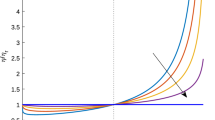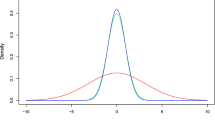Abstract
This paper investigates model specification problems for nonlinear stochastic differential equations with delay (SDDE). Compared to the model specification for conventional stochastic diffusions without delay, the observed sequence does not admit a Markovian structure so that the classical testing procedures may not be applicable. To overcome this difficulty, a moment estimator is newly proposed based on the ergodicity of SDDEs and its asymptotic properties are established. Based on the proposed moment estimator, a testing procedure is proposed for our model specification testing problems. Particularly, the limiting distributions of the proposed test statistic are derived under null hypotheses and the test power is examined under some specific alternative hypotheses. Finally, a Monte Carlo simulation is conducted to illustrate the finite sample performance of the proposed test.
Similar content being viewed by others
References
Aït-Sahalia Y (1996) Testing continuous-time models of the spot interest rate. Rev Financ Stud 9(2):385–426
Aït-Sahalia Y, Fan J, Peng H (2009) Nonparametric transition-based tests for jump diffusions. J Am Stat Assoc 104(487):1102–1116
Arriojas M, Hu Y, Mohammed SE, Pap G (2007) A delayed Black and Scholes formula. Stoch Anal Appl 25(2):471–492
Bao J, Wang FY, Yuan C (2020) Limit theorems for additive functionals of path-dependent SDEs. Discrete Contin Dyn Syst A 40(9):5173–5188
Benke JM, Pap G (2017) One-parameter statistical model for linear stochastic differential equation with time delay. Statistics 51(3):510–531
Bratsun D, Volfson D, Tsimring LS, Hasty J (2005) Delay-induced stochastic oscillations in gene regulation. Proc Natl Acad Sci 102(41):14593–14598
Chen L, Yu Z (2014) Maximum principle for nonzero-sum stochastic differential game with delays. IEEE Trans Autom Control 60(5):1422–1426
Chen SX, Gao J, Tang CY (2008) A test for model specification of diffusion processes. Ann Stat 36(1):167–198
Dachian S, Kutoyants YA (2008) On the goodness-of-fit tests for some continuous time processes. In: Vonta F et al (eds) Statistical models and methods for biomedical and technical systems. Birkhäuser, Boston, pp 385–403
Gushchin AA, Küchler U (1999) Asymptotic inference for a linear stochastic differential equation with time delay. Bernoulli 5(6):1059–1098
Hobson DG, Rogers LC (1998) Complete models with stochastic volatility. Math Financ 8(1):27–48
Hong Y, Li H (2005) Nonparametric specification testing for continuous-time models with applications to term structure of interest rates. Rev Financ Stud 18(1):37–84
Ivanov AF, Swishchuk AV (2008) Optimal control of stochastic differential delay equations with application in economics. Int J Qualit Theory Differ Equ Appl 2(2):201–213
Karatzas I (1996) Anticipative portfolio optimization. Adv Appl Probab 28(4):1095–1122
Kleptsyna M, Kutoyants YA (2014) On asymptotically distribution free tests with parametric hypothesis for ergodic diffusion processes. Stat Infer Stoch Process 17(1):295–319
Küchler U, Sørensen M (2010) A simple estimator for discrete-time samples from affine stochastic delay differential equations. Stat Infer Stoch Process 13(1):125–132
Küchler U, Kutoyants YA (2000) Delay estimation for some stationary diffusion-type processes. Scand J Stat 27(3):405–414
Küchler U, Sørensen M (2013) Statistical inference for discrete-time samples from affine stochastic delay differential equations. Bernoulli 19(2):409–425
Kutoyants YA (2021) On multi-step estimation of delay for SDE. Bernoulli 27(3):2069–2090
Lawrence DB (2012) The economic value of information. Springer, New York
Lei J, Mackey MC (2007) Stochastic differential delay equation, moment stability, and application to hematopoietic stem cell regulation system. SIAM J Appl Math 67(2):387–407
López-Prez A, Febrero-Bande M, Gonzàlez-Manteiga W (2022) A comparative review of specification tests for diffusion models. arXiv:2208.08420
Marschak J (1971) Economics of information systems. J Am Stat Assoc 66(333):192–219
Mao X (2007) Stochastic differential equations and applications. Elsevier, Amsterdam
Negri I, Nishiyama Y (2009) Goodness of fit test for ergodic diffusion processes. Ann Inst Stat Math 61(4):919–928
Reiss M (2005) Adaptive estimation for affine stochastic delay differential equations. Bernoulli 11(1):67–102
Rihan FA (2021) Delay differential equations and applications to biology. Springer, Singapore
Steiner J, Stewart C, Matějka F (2017) Rational inattention dynamics: Inertia and delay in decision-making. Econometrica 85(2):521–553
Stoica G (2005) A stochastic delay financial model. Proc Am Math Soc 133(6):1837–1841
Vasicek O (1977) An equilibrium characterization of the term structure. J Financ Econ 5(2):177–188
Author information
Authors and Affiliations
Corresponding author
Ethics declarations
Statement on Conflict of interest
The authors claim that there is no conflict of interest about the manuscript submitted.
Additional information
Publisher's Note
Springer Nature remains neutral with regard to jurisdictional claims in published maps and institutional affiliations.
We thank the Editor (Professor Arnaud Gloter), the Associate Editor, and the anonymous referee for their constructive and helpful comments and suggestions that improved significantly the quality of the paper. This work is partially supported by Simons Foundation’s Travel Support for Mathematicians Program under Grant Number 00002835 and the Natural Science Foundation of China under Grant Numbers 72133002 and 72033008.
Appendix: General results on SDDEs
Appendix: General results on SDDEs
In this appendix, recall the ergodicity theory for SDDEs for our problem from Bao et al. (2020). Note that the following theorem is from Bao et al. (2020) concerning about the exponential ergodicity of SDDEs.
Theorem 5
Suppose Assumption 1 holds. Then, the followings are true.
(i) The Markov process \(\{X_t\}\) admits a unique invariant measure \(\mu \) on \(\mathscr {C}\) with for any \(p\ge 1\)
and
where \(L_p\) is a constant independent of \(\delta \).
(ii) If \(|g(\eta )|\le L \Vert \eta \Vert _{\mathscr {C}}^2\) for some \(L>0\), the following law of large numbers holds
almost surely.
(iii) For any \(h:\mathscr {C}\mapsto \mathbb {R}\) satisfying
one has
in distribution, where \(X_t^\eta \) is the solution to (1) with initial \(X_0=\eta \),
and
In particular, if \(h(\eta )=\mathcal{A}f(\eta (0),\eta ;\theta ^*)\) some twice continuously differentiable f with bounded second order derivatives, one has
Remark 2
Our statements (i) and (ii) are from (1.2) and Statement (2) in Theorem 1.1 from Bao et al. (2020), respectively. The statement (iii) is from Statement (1) in Theorem 1.2 from Bao et al. (2020).
For our testing problem, we finish the appendix with the following lemma concerning with the continuity of the invariant measure \(\mu (\cdot ;\theta )\) with respect to \(\theta \).
Lemma 2
Assume Assumption 1 holds and \(\sup _{\theta \in \Theta }\sup _{t\ge 0}\mathbb {E}\Vert X_t\Vert _\mathscr {C}^2<\infty \). Further, assume that \(|\sigma (\xi ,\theta )-\sigma (\eta ,\theta )|\le \lambda _3|\xi -\eta |_\mathscr {C}\) with \(\lambda _1>(\lambda _2+\lambda ^2_3)e^{-\lambda _1\tau }\). Then, as \(\theta \rightarrow \theta ^*\), \(\mu (\cdot ;\theta )\rightarrow \mu (\cdot ;\theta ^*)\) in distribution with
Proof
Suppose X(t) and Y(t) be the solution of SDDE (1) with same initial and \(\theta =\theta ^*\) and \(\theta _1\) respectively. Note that
Therefore, taking \(\delta >0\) such that \(\lambda _1>(\lambda _2+\lambda _3^2)e^{-\lambda _1\tau }\) yields that
where M is a martingale. Similar to the proof of Lemma 3.1 in Bao et al. (2020), one has
As \((X_t,Y_t)\) is an asymptotic coupling of \(\mu (\cdot ;\theta ^*)\) and \(\mu (\cdot ;\theta _1)\), this proves that \(\mu (\cdot ;\theta _1)\rightarrow \mu (\cdot ;\theta ^*)\) in distribution and (21) holds. The proof is complete. \(\square \)
Finally, a remark should be mentioned here that the condition in the above lemma is sufficient but not necessary. How to get a better condition is beyond the scope of our paper, thus omitted here, and it deserves a further investigation.
Rights and permissions
Springer Nature or its licensor (e.g. a society or other partner) holds exclusive rights to this article under a publishing agreement with the author(s) or other rightsholder(s); author self-archiving of the accepted manuscript version of this article is solely governed by the terms of such publishing agreement and applicable law.
About this article
Cite this article
Cai, Z., Mei, H. & Wang, R. A model specification test for nonlinear stochastic diffusions with delay. Stat Inference Stoch Process (2024). https://doi.org/10.1007/s11203-024-09309-2
Received:
Accepted:
Published:
DOI: https://doi.org/10.1007/s11203-024-09309-2
Keywords
- Model specification test
- Stochastic differential equation with delay
- Moment estimator
- Ergodicity
- Invariant measure
- Non-Markovian property




